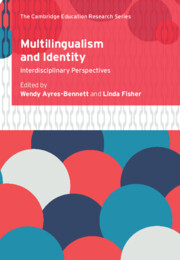Book contents
- Multilingualism and Identity
- Multilingualism and Identity
- Copyright page
- Contents
- Figures
- Tables
- Contributors
- 1 Towards Interdisciplinarity in Multilingual Identity Research
- Part I Situated Multilingualism and Identity
- Part II Multilingual Identity Practices
- Part III Multilingual Identity and Investment
- 13 Multilingualism(s), Globalization and Identity
- 14 Who Are the Multilinguals?
- 15 Multilingual Identity Construction through Participative Reflective Practice in the Languages Classroom
- 16 Young Children’s Language Attitudes with Implications for Identity in a US Dual-Language Immersion Classroom
- 17 Language, Identity and Empowerment in Endangered Language Contexts
- 18 Afterword
- References
- Index
13 - Multilingualism(s), Globalization and Identity
Learning ‘Chinese’ as an Additional Language
from Part III - Multilingual Identity and Investment
Published online by Cambridge University Press: 22 July 2022
- Multilingualism and Identity
- Multilingualism and Identity
- Copyright page
- Contents
- Figures
- Tables
- Contributors
- 1 Towards Interdisciplinarity in Multilingual Identity Research
- Part I Situated Multilingualism and Identity
- Part II Multilingual Identity Practices
- Part III Multilingual Identity and Investment
- 13 Multilingualism(s), Globalization and Identity
- 14 Who Are the Multilinguals?
- 15 Multilingual Identity Construction through Participative Reflective Practice in the Languages Classroom
- 16 Young Children’s Language Attitudes with Implications for Identity in a US Dual-Language Immersion Classroom
- 17 Language, Identity and Empowerment in Endangered Language Contexts
- 18 Afterword
- References
- Index
Summary
This chapter discusses the changing local and global contexts in which Chinese (i.e., one or more Chinese languages or dialects) is being learned by multilingual youth and adults. Case studies of heritage- and non-heritage transnational learners of Mandarin in Canada, the United States, Australia and China illustrate the multi-scalar influences and enactments of larger geopolitical initiatives, ideologies, investments, and power relations in Chinese education and the many forms of Chinese-involved multilingualism(s) that can result. The chapter then explores how these and other factors shape learners’ identities, forms of agency, and linguistic histories as well as their trajectories and (sometimes fraught) subjectivities as multilingual Sinophones. The chapter concludes with a call for additional research representing a wider range of multilingualisms, raciolinguistic identities (especially among non-Anglophone learners), and migration histories and trajectories in Chinese language learning.
- Type
- Chapter
- Information
- Multilingualism and IdentityInterdisciplinary Perspectives, pp. 261 - 280Publisher: Cambridge University PressPrint publication year: 2022

